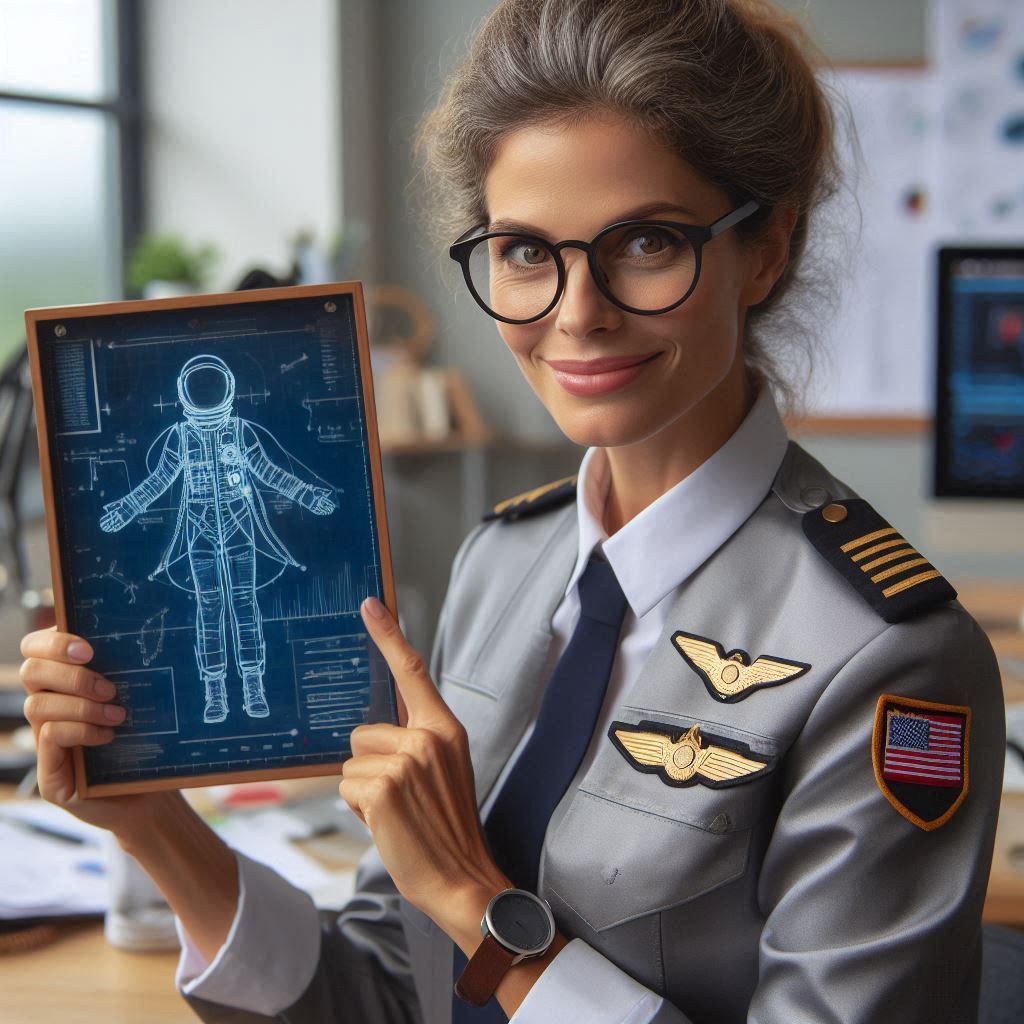Introduction
When it comes to the aerospace industry, having a well-written resume is crucial.
Your resume serves as your first impression to potential employers, highlighting your skills, experiences, and qualifications.
In such a competitive fh2ield, a strong resume can help you stand out among other candidates and increase your chances of landing your dream job in aerospace engineering.
A well-crafted aerospace engineering resume should include a summary of your professional background.
Highlighting your relevant experience, technical skills, and educational achievements.
It should also showcase any projects you have worked on, research you have conducted, and certifications you have obtained in the aerospace field.
Furthermore, including specific keywords related to aerospace engineering can help your resume get noticed by applicant tracking systems used by companies to screen resumes.
Tailoring your resume to the job description and using action verbs to describe your accomplishments can also make a strong impact on potential employers.
In addition, having a clean and organized layout, with clear headings and bullet points, can make your resume easy to read and navigate.
Including a professional summary at the top of your resume can also provide a quick overview of your qualifications and catch the eye of hiring managers.
Overall, a well-written aerospace engineering resume is essential for showcasing your expertise and qualifications to potential employers in the industry.
By following these tips and guidelines, you can create a standout resume that will help you land your next aerospace engineering job.
Understand the Basics of Resume Writing
The Essential Components of a Resume
Creating an effective aerospace engineering resume involves including key components that highlight your qualifications.
Begin with your contact information, including your name, phone number, email, and LinkedIn profile.
This information should be at the top of the resume, making it easy for employers to reach you.
Next, include an objective or summary statement.
This section should be brief, summarizing your career goals and key qualifications.
Tailor the statement to the specific position you are applying for, emphasizing your passion for aerospace engineering and relevant experience.
Work Experience
The work experience section is crucial for showcasing your hands-on skills and professional achievements.
List your previous jobs in reverse chronological order, starting with the most recent position.
For each role, include the job title, company name, location, and dates of employment.
Under each job entry, describe your responsibilities and achievements using bullet points.
Focus on specific tasks that are relevant to aerospace engineering, such as designing components, conducting tests, or managing projects.
Use action verbs and quantify your accomplishments when possible, such as “Led a team of five engineers” or “Improved testing efficiency by 20%.”
Education
The education section should include your academic background, highlighting degrees related to aerospace engineering.
List your degrees in reverse chronological order, starting with the highest degree obtained.
Include the name of the institution, degree obtained, major, and graduation date.
Mention relevant coursework or projects that align with the job you are applying for.
If you have a high GPA, consider including it as well, especially if you are a recent graduate.
Skills
The skills section is where you showcase your technical and soft skills.
List skills that are specific to aerospace engineering, such as proficiency in CAD software, knowledge of aerodynamics, or experience with simulation tools.
Also, include soft skills like teamwork, problem-solving, and communication, which are valuable in any engineering role.
Be honest about your proficiency levels and avoid listing skills that are not relevant to the job.
Tailor this section to match the requirements listed in the job description.
Certifications
Certifications can set you apart from other candidates and demonstrate your commitment to the field.
Include any relevant certifications, such as those in project management, Six Sigma, or specific engineering software.
Mention the certifying organization and the date obtained.
Tips on How to Organize This Information Effectively
Organizing your resume effectively is crucial for making a strong impression.
Use a clean and professional layout with consistent formatting.
Choose a standard font, like Arial or Times New Roman, and keep the font size between 10 and 12 points.
Use bold headings to separate different sections, such as Contact Information, Objective, Work Experience, Education, Skills, and Certifications.
Keep your resume to one page, unless you have extensive experience that justifies a longer document.
Prioritize information based on relevance to the job you are applying for.
Tailor your resume for each application, emphasizing the most pertinent skills and experiences.
Proofread your resume carefully to avoid typos and grammatical errors.
Writing an aerospace engineering resume requires attention to detail and strategic organization.
Include essential components such as contact information, an objective or summary, work experience, education, skills, and certifications.
Use clear and concise language to highlight your qualifications, tailoring the resume to each specific job application.
By following these guidelines, you can create a resume that effectively showcases your skills and experience.
Helping you stand out in the competitive field of aerospace engineering.
Tailor Your Resume to the Aerospace Industry
When applying for a job in aerospace engineering, it is crucial to customize your resume to align with the specific requirements of the industry.
Highlighting your relevant skills and experiences can significantly increase your chances of landing your dream job.
The Importance of Customizing Your Resume
Customizing your resume is crucial for standing out in the aerospace engineering field.
A tailored resume demonstrates that you understand the specific requirements of the job.
It shows that you‘ve taken the time to align your skills and experiences with the role.
Start by carefully reading the job description.
Identify key skills, qualifications, and experiences the employer values.
Customize your resume to highlight these aspects, ensuring your resume reflects your suitability for the position.
This focused approach makes your application more relevant and compelling to hiring managers.
Use your resume to showcase your technical expertise and practical experience.
Include projects, internships, and research that directly relate to aerospace engineering.
Highlight specific tasks and achievements that demonstrate your proficiency in areas like propulsion systems, aerodynamics, or spacecraft design.
How to Incorporate Keywords and Industry-Specific Terminology
Incorporating keywords and industry-specific terminology in your resume is essential.
Many companies use applicant tracking systems (ATS) to screen resumes.
These systems scan for specific keywords related to the job.
Including relevant terms increases the likelihood that your resume will pass the initial screening.
To identify the right keywords, review the job description and the company’s website.
Look for terms frequently mentioned, such as “aerodynamics,” “CAD software,” or “flight testing.
” Use these keywords naturally throughout your resume, particularly in the skills and experience sections.
Highlight your proficiency with industry-standard tools and software.
Mention your experience with programs like MATLAB, ANSYS, or SolidWorks.
This signals to employers that you have the technical skills needed for the job.
If you have certifications in specific software or methodologies, include these as well.
Showcase Relevant Skills and Experiences
Focus on showcasing relevant skills and experiences that match the job requirements.
Use bullet points to clearly list your achievements and responsibilities.
For example, describe specific projects where you applied your engineering skills to solve complex problems.
Highlight any leadership roles or team collaborations that demonstrate your ability to work in a multidisciplinary environment.
Quantify your achievements when possible.
Mention the impact of your work, such as improving design efficiency by a certain percentage or reducing project costs.
Quantifying your accomplishments provides concrete evidence of your capabilities and contributions.
Include a summary or objective statement at the top of your resume.
This section should briefly outline your career goals and highlight your most relevant skills and experiences.
Tailor this statement to each job application, emphasizing what you bring to the role and how you align with the company’s goals.
Writing an effective aerospace engineering resume requires careful customization, strategic use of keywords, and a clear presentation of your skills and experiences.
Customize your resume to match the job description, showcasing your technical expertise and relevant experiences.
Incorporate industry-specific terminology to pass ATS screenings and impress hiring managers.
Highlight your achievements and quantify your contributions to provide concrete evidence of your capabilities.
By following these strategies, you can create a compelling resume that increases your chances of landing your desired aerospace engineering role.
Read: Economic Indicators and Their Influence on US Architects
Showcase Your Technical Skills
The Specific Technical Skills Valued in Aerospace Engineering
Creating an effective aerospace engineering resume requires highlighting specific technical skills.
Employers highly value proficiency in CAD software, knowledge of aerodynamics, and experience with spacecraft design.
These skills demonstrate your technical expertise and ability to contribute to aerospace projects.
Proficiency in CAD software, such as CATIA, SolidWorks, or AutoCAD, is essential.
CAD software is used extensively in designing aircraft and spacecraft components.
It allows engineers to create precise models, perform simulations, and optimize designs for performance and manufacturability.
Knowledge of aerodynamics is another critical skill.
Aerodynamics principles are fundamental in designing efficient and safe aircraft and spacecraft.
Engineers must understand airflow, drag, lift, and other forces that impact the performance and stability of vehicles.
Experience with spacecraft design is increasingly valuable as the space industry grows.
This includes knowledge of systems engineering, propulsion, and orbital mechanics.
Engineers with spacecraft design experience can contribute to projects involving satellites, space exploration, and commercial spaceflight.
Examples of Demonstrating These Skills in the Experience Section
When listing experience on your resume, clearly demonstrate your technical skills.
Use specific examples to show how you applied these skills in practical settings.
This approach helps employers see your capabilities and the impact of your work.
For CAD software proficiency, mention specific projects where you used these tools.
To demonstrate knowledge of aerodynamics, describe projects where you analyzed or optimized aerodynamic performance.
For instance, “Conducted wind tunnel tests to assess drag reduction strategies for a UAV, improving fuel efficiency by 10%.
” This example shows your hands-on experience and understanding of aerodynamics principles.
Experience with spacecraft design can be highlighted by detailing relevant projects.
For example, “Developed propulsion system models for a low Earth orbit satellite, enhancing maneuverability and mission lifespan.
” This statement emphasizes your experience in spacecraft systems and your contribution to a successful project.
Including technical skills in your resume’s skills section is also important.
List relevant software, tools, and technologies you are proficient in.
Proficiency in CAD software, knowledge of aerodynamics, and experience with spacecraft design are highly valued in the industry.
These skills demonstrate your ability to contribute to complex aerospace projects.
In the experience section of your resume, provide specific examples of how you applied these skills.
Mention projects and achievements that highlight your technical expertise and impact.
Use quantifiable results to strengthen your claims and make your resume stand out.
Including a skills section with relevant software and tools further emphasizes your qualifications.
A well-crafted resume that effectively communicates your technical skills and experiences can significantly enhance your job prospects in the aerospace engineering field.
Read: Post-Pandemic Design Trends: US Architects Adapt
Highlight Your Achievements
Encourage Applicants to Include Quantifiable Achievements
When crafting an aerospace engineering resume, it’s crucial to include quantifiable achievements.
These demonstrate your impact and capabilities, making your resume more compelling to potential employers.
Quantifiable achievements provide concrete evidence of your skills and contributions to projects.
Include successful projects that showcase your expertise in specific areas.
For example, “Led a team in designing a UAV, reducing production costs by 20% through efficient material usage.
” This statement highlights a tangible result and your leadership skills.
Research publications are another valuable addition to your resume.
Mention publications where you contributed significantly, such as “Co-authored a paper on advanced propulsion systems published in [Journal Name].
” This shows your ability to contribute to scholarly work and stay engaged with current research.
Awards and honors can also enhance your resume.
They provide external validation of your skills and achievements.
For example, “Received the [Award Name] for outstanding research in aerodynamics.
” This recognition adds credibility and distinguishes you from other candidates.
Transform Your Career Today
Unlock a personalized career strategy that drives real results. Get tailored advice and a roadmap designed just for you.
Start NowGuidance on Using Bullet Points and Action Verbs
To make accomplishments stand out, use bullet points and action verbs in your resume.
Bullet points help organize information clearly, making it easier for employers to scan your achievements.
Action verbs convey a sense of initiative and responsibility, enhancing the impact of your statements.
When listing your achievements, start each bullet point with a strong action verb.
For example, use verbs like “developed,” “designed,” “led,” “improved,” and “implemented.
” These words emphasize your active role in projects and convey a sense of accomplishment.
Be specific in your descriptions and focus on the outcomes of your actions.
For example, “Developed a new composite material for aircraft wings, increasing strength-to-weight ratio by 15%.
” This statement clearly communicates the result of your work and its significance.
When describing teamwork or collaborative projects, highlight your contributions and leadership.
For instance, “Coordinated a team of engineers to streamline the testing process, reducing time-to-market by 10%.
” This demonstrates your ability to work effectively in a team and manage projects.
” These metrics provide a clear, measurable impact of your work.
Including quantifiable achievements in your aerospace engineering resume is essential for demonstrating your impact and capabilities.
Successful projects, research publications, and awards highlight your expertise and contributions.
Bullet points organize information clearly, while action verbs emphasize your active role and initiative.
Be specific and include metrics to quantify your achievements, providing clear evidence of your impact.
A well-structured resume that effectively highlights your accomplishments can significantly enhance your job prospects in the aerospace engineering field.
By showcasing your skills and achievements, you present yourself as a capable and valuable candidate to potential employers.
Read: Freelance vs. Firm: Career Paths for US Architects

Emphasize Teamwork and Collaboration
Importance of Teamwork and Collaboration in Aerospace Engineering Projects
Teamwork and collaboration are vital components of aerospace engineering projects.
Aerospace engineering involves complex systems that require expertise from various disciplines.
Engineers must work together to design, test, and implement solutions effectively.
The success of aerospace projects often depends on seamless collaboration among team members.
Employers value candidates who can work well in team environments.
Effective collaboration ensures that projects are completed efficiently and meet quality standards.
It also fosters innovation, as team members bring diverse perspectives and expertise to solve challenging problems.
Highlighting your teamwork skills on your resume demonstrates your ability to contribute positively to a collaborative work environment.
Tips on How to Showcase Your Ability to Work Effectively in a Team Environment
To showcase your teamwork skills on your resume, focus on group projects and collaborative research experiences.
Start by describing specific projects where you worked as part of a team.
Highlight your role in these projects, emphasizing your contributions and how you collaborated with others.
Use action verbs like “collaborated,” “coordinated,” “facilitated,” and “participated” to describe your involvement in team activities.
For example, “Collaborated with a team of engineers to design and test a new propulsion system.”
This language demonstrates your active participation and ability to work well with others.
Provide concrete examples that illustrate your teamwork skills.
Mention instances where you resolved conflicts, contributed to brainstorming sessions, or supported teammates in achieving project goals.
These examples show that you not only work well in teams but also help foster a positive and productive team environment.
Highlight Group Projects and Collaborative Research Experiences
When discussing group projects, focus on the project’s goals, your role, and the outcome.
Describe how your team approached the problem, the methodologies used, and the project’s impact.
Highlight any specific challenges the team faced and how you contributed to overcoming them.
For example, you could write, “Participated in a team project to design a lightweight satellite structure.
Coordinating with materials specialists and aerodynamic experts.
Contributed to material selection and testing, resulting in a 10% reduction in overall weight.
If you have been involved in collaborative research, detail your contributions and the research’s significance.
Mention how you worked with other researchers, shared data, and co-authored papers or presentations.
This shows your ability to collaborate in academic or research settings, which is highly relevant in aerospace engineering.
Include Soft Skills and Teamwork Attributes
In addition to technical skills, emphasize soft skills that support effective teamwork.
Mention attributes like strong communication, adaptability, and conflict resolution.
These skills are crucial in ensuring smooth interactions and successful collaboration.
In your resume’s skills section, include phrases like “team collaboration,” “cross-functional communication,” and “project coordination.
” These keywords can catch the attention of hiring managers and applicant tracking systems.
Emphasizing teamwork and collaboration skills on your aerospace engineering resume is essential.
Employers look for candidates who can work effectively in diverse teams to tackle complex engineering challenges.
Highlight your experiences in group projects and collaborative research, showcasing your role and contributions.
Use specific examples to illustrate your teamwork abilities and include soft skills that facilitate collaboration.
By presenting yourself as a team player with strong collaborative skills, you can increase your appeal to potential employers in the aerospace industry.
Read: Iconic US Buildings and the Architects Behind Them.
Learn More: Industrial Engineering vs. Mechanical Engineering
Include Relevant Internships or Co-op Experiences
When it comes to building a strong aerospace engineering resume.
Including relevant internships or co-op experiences can greatly enhance your chances of landing an entry-level position in the industry.
The Value of Internships or Co-Op Experiences in Gaining Practical Skills and Industry Exposure
Internships and co-op experiences are invaluable for aspiring aerospace engineers.
They provide practical skills and real-world exposure that classroom learning alone cannot offer.
These experiences allow students to apply theoretical knowledge to actual projects, gaining hands-on experience with aerospace systems and technologies.
During internships or co-op programs, students work on a range of tasks, from design and testing to analysis and project management.
This exposure helps them understand the workflow and challenges of aerospace projects.
It also familiarizes them with industry standards and practices, making them more prepared for professional roles.
These experiences also provide networking opportunities, allowing students to build connections with professionals in the field.
This network can be instrumental in securing future job opportunities and gaining insights into the industry.
Employers often value candidates with practical experience, as it indicates readiness to handle real-world challenges.
Advice on Highlighting These Experiences on Your Resume
To effectively showcase internships and co-op experiences on your resume, focus on specific contributions and skills gained.
Clearly detail your responsibilities and achievements, emphasizing how these experiences prepared you for an entry-level position.
In the experience section, list each internship or co-op with the position title, company name, and dates of employment.
Use bullet points to describe your key responsibilities and accomplishments.
For example, “Assisted in the design and testing of an aircraft wing prototype, contributing to a 5% weight reduction.”
Highlight technical skills and tools you used, such as CAD software, simulation tools, or lab equipment.
For instance, “Utilized SolidWorks for creating detailed component designs and ANSYS for structural analysis.”
This shows your practical experience with essential industry tools.
For example, “Collaborated with a team of engineers to conduct wind tunnel testing, improving aerodynamic efficiency by 8%.”
Quantifying achievements can make your resume more impactful.
Use specific numbers to demonstrate the scale of your contributions.
For example, “Awarded ‘Outstanding Intern’ for exceptional performance and innovative contributions.”
Internships and co-op experiences are crucial for gaining practical skills and industry exposure in aerospace engineering.
They allow students to apply theoretical knowledge to real-world projects, preparing them for professional roles.
These experiences also offer networking opportunities, helping students build valuable connections in the industry.
When highlighting these experiences on your resume, focus on specific responsibilities, skills gained, and accomplishments.
Detail your contributions to projects, use technical terms, and quantify your achievements.
This approach demonstrates your readiness for entry-level positions and makes your resume stand out to potential employers.
A well-presented resume that effectively showcases your internships and co-op experiences can significantly enhance your job prospects in the aerospace engineering field.
It shows that you have practical experience, technical skills, and a readiness to contribute to the industry.
Discover More: Geotechnical Engineering Certifications Explained
See Related Content: Top Software Tools for Systems Engineering Projects
Conclusion
In this blog post, we’ve covered the essential elements for writing a standout aerospace engineering resume.
Emphasizing technical skills, such as proficiency in CAD software, and detailing relevant work experience, including internships and projects, are key to showcasing your qualifications.
Highlighting specific achievements, like contributions to aerospace design or successful project completions, helps demonstrate your value to potential employers.
Crafting a tailored resume for each job application is crucial in the aerospace industry, where competition is high.
Take the time to research the company’s specific needs and align your skills and experiences with their requirements.
A well-structured resume not only highlights your technical expertise but also your ability to communicate effectively and work within a team, which are vital attributes in this field.
Investing effort into creating a polished and targeted resume can significantly impact your job search success.
A thoughtfully prepared resume not only opens doors to opportunities but also positions you as a strong candidate in the eyes of recruiters and hiring managers.
Remember, your resume is your first impression. Present yourself as a capable aerospace engineer ready to contribute to innovative projects and advancements.
[E-Books for Sale]
The Big Book of 500 High-Paying Jobs in America: Unlock Your Earning Potential
$19.99 • 500 High-Paying Jobs • 330 pages
Explore 500 high-paying jobs in America and learn how to boost your career, earn more, and achieve success!
See All 500 High-Paying Jobs of this E-Book
1001 Professions Without a Degree: High-Paying American Jobs You Can Start Now
$19.99 • 1001 Professions Without a Degree • 174 pages
Discover 1001 high-paying jobs without a degree! Unlock career tips, skills, and success strategies for just $19.99!




